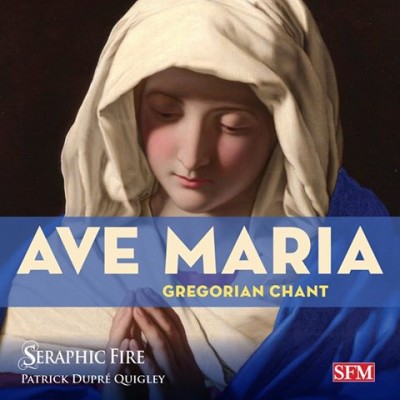
New Seraphic Fire disc evokes serenity, contemplation
One of the most striking things about the Seraphic Fire ensemble is its ferocious work ethic when it comes to recordings. I’ve had occasion to mention several of their discs on this blog as they’ve come out, and next week (Aug. 6), the group’s latest record, a collection of Gregorian chant and Renaissance motets drawn from those plainsongs, comes out in digital form. (It’s out in CD on Aug. 27.)
The recording is called Ave Maria, and features music of Marian worship in the form of the Compline hymns that were chanted at the end of each monastic day. Recorded in Fort Lauderdale’s All Saints Episcopal Church in January, just after the group’s Gregorian chant concerts, the recording contains compositions by Guerrero and Victoria (Spain), Leonel Power and John Dunstaple (England), Palestrina (Italy) and Josquin (France). The longest work on the program is an eight-voice Salve Regina by Victoria, a difficult and solemnly beautiful piece from the last years of the 16th century.
The rest of the recording is plainchant, from a variety of sources ranging from a 13th-century example from the Sarum rite (in the English city of Salisbury), Gregorian and Ambrosian chant, and plainsong from Spain and France. Each kind of chant has its own musical style, which makes the recording more interesting than it would have been had it all been Gregorian chant followed by the composed elaborations. The Sarum chant, for instance, a setting of the Alma redemptoris mater (Mother of the Redeemer), is much closer to what we might think of as a conventional melody than some of the other examples.
Director Patrick Dupré Quigley also makes sure to vary the voices that sing that chant, with female voices alone on the Alma redemptoris mater and just the men on the Ave, maris stella (Hail, star of the sea). Surely there were good musicological reasons for the voice assignments, but tonal shade is just as compelling a justification. Listening to chant can be tough going for some listeners, even if it’s brief, and having an assortment of vocal timbres gives this ancient music more color.
On initial listens, these are lovely performances, with Guerrero’s setting of the Alma redemptoris mater and Josquin’s Ave Maria … Virgo serena especially noteworthy. The Victoria Salve Regina suffers from some slightly pinched intonation in the initial bars, but later on relaxes into a cool, dark beauty. Most of the chant singing, too, is admirably smooth and inviting. Another work by Victoria, Regina caeli laetare (Queen of Heaven, rejoice), ends the program in an exemplary way, with its vigorous, rhythmic Alleluias a marked contrast to the atmosphere of serene devotion that prevails in most of the program.
The Miami-based choir’s upcoming season opens in mid-October with similar repertory, in a concert devoted to Renaissance music from the Sistine Chapel. In the meantime, this new recording brings us in contact with what Quigley calls music “close to the ensemble’s heart,” the sacred repertory of the 15th, 16th and 17th centuries, music that saw the rise of composers who are at the foundation of the Western classical music tradition.
Recent Content
-
Artsarticle ·
-
Artsarticle ·
-
Artsarticle ·

